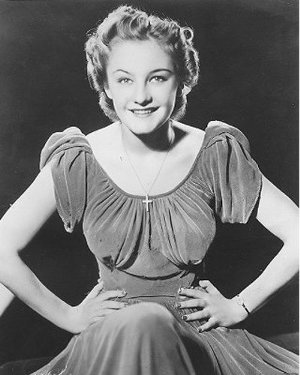Irene Daye

-
Birth Name
Irene Endyke -
Born
January 16, 1918
Lawrence, Massachusetts -
Died
November 1, 1971 (age 53)
Greenville, South Carolina -
Orchestras
Sam Donahue
Mal Hallett
Gene Krupa
Dan Murphy
Charlie Spivak
Singer Irene Daye got her start in the mid-1930s but is best remembered for her work with the bands of Gene Krupa and Charlie Spivak during the early 1940s. Daye recorded several minor hits with both orchestras before going solo in 1945. After returning to Spivak in 1947, she married him in 1950 and retired from show business.
Born in Lawrence, Massachusetts, Daye’s grandparents on both sides of her family immigrated to the United States from Poland in the later part of the nineteenth century.[1] Little is known of her early life. She landed her first professional singing job with orchestra leader Dan Murphy in 1935 shortly before her high school graduation. She flew back to her hometown on graduation night to receive her diploma.
Daye remained with Murphy two-and-a-half years before joining Mal Hallett’s band around the beginning of 1938. In mid-1938, Gene Krupa heard her sing at an engagement in Philadelphia and asked her to try out for his orchestra. When her night’s work with Hallett had ended, she made a 4 a.m. audition and landed the job.
With Krupa, Daye found success, singing on such popular records as “Drum Boogie” and “Drummin’ Man.” Daye remained with Krupa until February 1941, when she quit and travelled to the West Coast to marry left-handed trumpeter Edward “Corky” Cornelius, who had recently left Krupa to join the Casa Loma Orchestra. She then sang for Sam Donahue, who had also recently left Krupa to front his own band again.
After the birth of her first child, a daughter, in 1943, Daye retired from show business. Sadly, Cornelius passed away from nephritis in August of that year, and Daye returned to singing, joining Charlie Spivak by October. With Spivak, Daye found even greater success, making several popular records with the band, including “Baby Won’t You Please Come Home,” “It’s Been a Long, Long Time,” “Golden Earrings,” and “I’ll Never Say Goodbye.”
Daye left Spivak in September 1945 to try her luck solo, doing radio work. She returned to Spivak in mid-1947. Daye and Spivak eventually found romance and married in January 1950. Daye then retired from singing again.
In the late 1950s, Spivak and Daye moved to Miami, Florida, where he fronted a small outfit with Daye managing his business affairs. Illness forced him to retire briefly in 1963. After recovering, he led bands in Las Vegas and Miami before organizing another small outfit in 1967 that played regularly at the Ye Olde Fireplace restaurant in Greenville, South Carolina, with Daye as vocalist. Daye battled cancer during the last years of her life, finally losing her fight in 1971, age 53.
Notes
Most modern sources give January 17 as Daye’s date of birth, though her birth records indicate that she was born on January 16. She was the last recorded birth for that day and was born at home. ↩︎
Sources
- Simon, George T. The Big Bands. 4th ed. New York: Schirmer, 1981.
- Walker, Leo. The Wonderful Era of the Great Dance Bands. Garden City, New York: Doubleday, 1972.
- Advertisement. “Nu-Elm Ballroom: Mal Hallett.” The Salem, Ohio, News 26 Mar. 1938: 8.
- “Orchestra Notes.” Billboard 11 Jun. 1938: 12.
- Shaltz, Si. “Vaudeville Reviews: Earle, Philadelphia.” Billboard 6 Aug. 1938: 20.
- Honigberg, Sam. “Night Club Reviews: Panther Room, College Inn, Chicago.” Billboard 25 Mar. 1939: 19.
- Krupa, Gene. “Critics in the Doghouse.” Down Beat May 1939: 13.
- “Vaudeville Reviews: Chicago, Chicago.” Billboard 10 Aug. 1940: 22.
- “Vaudeville Reviews: Chicago, Chicago.” Billboard 15 Feb. 1941: 22.
- “Quits Chirping To Wed.” Down Beat 1 Mar. 1941: 1.
- “Tied Notes.” Down Beat 15 Mar. 1941: 10.
- “Corky Cornelius Dies In New York.” Down Beat 15 Aug. 1943: 1.
- “The Final Curtain.” Billboard 21 Aug. 1943: 29.
- “Strictly Ad Lib.” Down Beat 1 Oct. 1943: 5.
- “Orchestra Notes.” Billboard 16 Oct. 1943: 16.
- “Spivak Singer.” Down Beat 1 Nov. 1943: 1.
- “Vaudeville Reviews: Earle, Philadelphia.” Billboard 11 Mar. 1944: 25.
- “Irene Daye Is Singer in Spivak Orchestra.” The Montreal Gazette 18 Jun. 1945: 2.
- “Strictly Ad Lib.” Down Beat 1 Oct. 1945: 1.
- Ehrlich, Evelyn. “Here's News Capsule of Music World for 1945.” Down Beat 1 Jan. 1946: 3.
- Advertisement. “Charlie Spivak.” Down Beat 22 Oct. 1947: 5.
- Brown, Dorothy. “Sweetest Trumpet Was Child Violinist.” Down Beat 31 Dec. 1947: 14.
- “Night Club Reviews: Chase Club, St. Louis.” Billboard 6 Mar. 1948: 40.
- “Vaudeville Reviews: Capitol, New York.” Billboard 26 Feb. 1949: 49.
- “Tied Notes.” Down Beat 10 Mar. 1950: 10.
- “Sidemen Switches.” Down Beat 5 May 1950: 6.
- Obituary. The Deseret News [Salt Lake City, Utah] 3 Nov. 1971: 4A.
- “Massachusetts State Vital Records, 1841-1925,” FamilySearch (https://www.familysearch.org/ark:/61903/1:1:QLKG-H7BX : Thu May 23 03:40:36 UTC 2024), Entry for Irena Indyk and Adam Indyk, 16 Jan 1918.
- “United States Census, 1920,” FamilySearch (https://www.familysearch.org/ark:/61903/1:1:MXYJ-35V : Fri Dec 08 00:18:42 UTC 2023), Entry for Sophie Endyke and Adam Endyke, 1920.
- “United States Census, 1930,” FamilySearch (https://www.familysearch.org/ark:/61903/1:1:XQLL-3HV : Thu Oct 05 02:02:13 UTC 2023), Entry for Adam Endyke and Bella Endyke, 1930.
- “United States, GenealogyBank Historical Newspaper Obituaries, 1815-2011,” FamilySearch (https://www.familysearch.org/ark:/61903/1:1:Q5SQ-33FN : Fri Mar 15 04:07:20 UTC 2024), Entry for Mrs Irene Daye Spivak and Charlie Spivak, 03 Nov 1971.